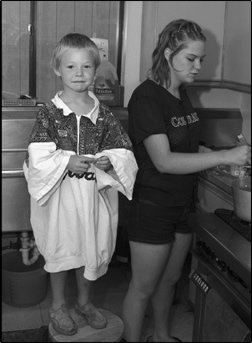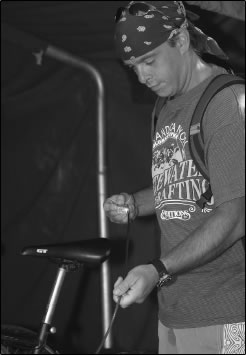 |
| Paula Rose Downer, 6, gets
a birds-eye view of lunch while Julie Stanley tends to
the stove at the Durango Community Shelter, which is
run by Volunteers of America. John Gamble, VOA division
director and supervisor of the shelter, said the majority
of shelter residents are local individuals and families
who have fallen on hard times./Photo by Todd Newcomer. |
For most, the word “homeless” conjures
up images of a middle-aged, male drifter with an alcohol
problem. John Gamble, Volunteers of America division director
and supervisor of the Durango Community Shelter, is the first
to admit that Durango has a growing homeless problem. However,
Gamble adds that the majority of Durango’s homeless
population does not fit the stereotype. Most of the people
seeking relief at the Durango Community Shelter are local
individuals and families who have fallen on hard times.
“
A lot of people think of the homeless person as single, male
and chemically dependent or chronically ill,” Gamble
said. “We have all types in Durango, but predominantly
we have individuals and families that are trying to make
it in this community.”
On the evening of Monday, Aug. 11, 16 men, nine women and
nine children spent the night in the community shelter. A
week earlier 41 people called the renovated house on Durango’s
west side home. People have been utilizing the Durango Community
Shelter since it first opened its doors in February of 1991.
“
The reality and humanity is that these people are not different
people than us,” Gamble said.
This is sentiment shared by the Durango Police Department.
According to Sgt. Tony Archuleta, incidents involving homeless
people are nearly nonexistent.
“
There’s really nothing that we deal with that’s
out of the ordinary,” he said. “Probably our
biggest thing is occasionally people will hide their backpacks
or belongings, and we’ll get calls reporting them as
lost.”
As for crimes of a violent nature, Archuleta said, “I
can’t even think of a single call on things as simple
as homeless people pandering for money.”
Last year, the Durango Community Shelter provided housing
to 561 people in need and served 28,233 meals. Gamble said
he expects that number to grow this year and cites a growing
discrepancy between wages and the cost of housing as the
cause.
“I think times are tough right now,” he said. “I think the
job market is tighter, and in our community, the cost of housing is impacting
people’s ability to make it.
“
The wage scale hasn’t changed in a lot of years,” Gamble continued. “In
the same time, the cost of living here has. Since I bought my home in 1990, its
value has tripled. My wages have not.”
Durango Mayor Virginia Castro echoed this assessment, saying that homelessness
is not something that only happens to other people. “I think one of the
main things to think about when we talk bout homelessness is that in today’s
economy, most of us could be just a month or two away from that condition.”
Tough love
Gamble said that the shelter operates on the principle of
a “hand up rather than a
 |
| Christian Chemero unlocks a community
bicycle available for use by the shelter residents./Photo
by Todd Newcomer |
hand out.” People
are welcome to stay for two weeks, assuming they meet
strict criteria.
“
Typically, when you come here, assuming you’re willing
to remain chemical and violence free and participate in a
daily chore, you can stay for two weeks,” Gamble said. “On
any given day most of the able-bodied adults are going to
work. It’s not like itjust a place to hang out and
crash.”
In this way, the shelter encourages and helps people
to get back on their feet, according to Gamble. “There are
things that one would never know about trying to start over
and get an anchor in life,” he said. “If you
walk up to an employer with a backpack, they’ll probably
pick the next guy. If you’re down and out and only
have the clothes on your back, how do you get clean?”
To this end, the shelter provides not just a safe place
to live but a semi-permanent address, a phone number,
laundry
facilities and three square meals a day. Once the two
weeks have expired, residents have an opportunity to
apply for
a transitional-living program.
“
To be accepted, they have to have a full-time job,” Gamble
said. “They have to be, in our assessment, really working
on some goals. If they are, they can stay for up to three
months in transitional living.”
A nominal rent is charged, and while Gamble said that
it represents some revenue for the shelter, it has another
purpose
as well. “It’s also a recognition that you shouldn’t
get out of the practice of paying your way through life,” he
said.
Back on track
Gamble cited a long list of success stories. In the shelter’s
first year, it helped a family of Durango natives bounce
back. The family had moved to Oklahoma and lost everything
when their plan didn’t work out. The shelter enabled
them to get back on their feet in Durango, regain housing
and move back into normal life. Last year, the shelter provided
housing for a family of 13 that had lost their home and a
family member to fire. After three months, the family was
able to move into a new home and start over again.
“
We see a lot of families and individuals get on their feet
and get housing,” Gamble said.
On the other hand, he said that there is another side
to the local homeless population. “There’s another
group, and they’re in any community, and they’re
just barely making it,” Gamble said. “Those folks
are part of our town, and they can make it most of the time,
but they’re the most vulnerable.”
Regardless of their prospects for success, the shelter
continues to extend help to these people. “From time to time,
there are people who we give a hand up to, knowing we may
see them again,” Gamble said.
And while he said that not every homeless person in Durango
is being helped right now, the Durango Community Shelter
is doing a more than adequate job.
“
We do turn away people from time to time,” he said. “We
can be full.”
In spite of this fact, Gamble said that the shelter more
than meets the needs of the Durango community. “I’m
not interested in expanding bed capacity,” he said. “I
think we do enough for a town of this size. We’re doing
an awful lot to help people get back on their feet.”
Local support
Volunteers of America, a national organization, operates
not only the Durango Community Shelter but the Southwest
Safehouse, a domestic abuse shelter, and the VOA Thrift
Store. Gamble said that the organization draws on some
federal funding
and the proceeds from the thrift store, but that the
State of Colorado provides no support for homeless shelters.
He
noted that the majority of dollars for the Durango Community
Shelter are local.
“
The majority of our funds come from community support and
local donors,” he said. “Local government is
also quite supportive. Both the city of Durango and La Plata
County have been very generous.”
Elaborating on the city’s reasons for supporting the
shelter, Castro said: “These are respectable people
who have lost their way. I think it’s really important
that as a society we take care of these people in need.”
Citing instances of abundant support by local citizens,
Gamble referred to $250,000 that was given outright by
an anonymous
local donor to the shelter for upgrades and an addition.
He noted that hundreds of community members come in and
cook dinner on a nightly basis throughout the year.
“
I think when you share with people that women and children
are sleeping under the bridge, they find their pocketbooks,” Gamble
said.
For more information on the Durango Community Shelter,
call 259-1255.

